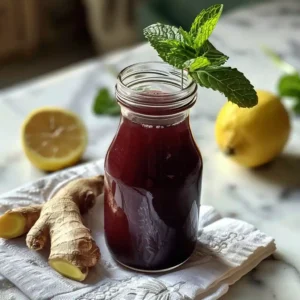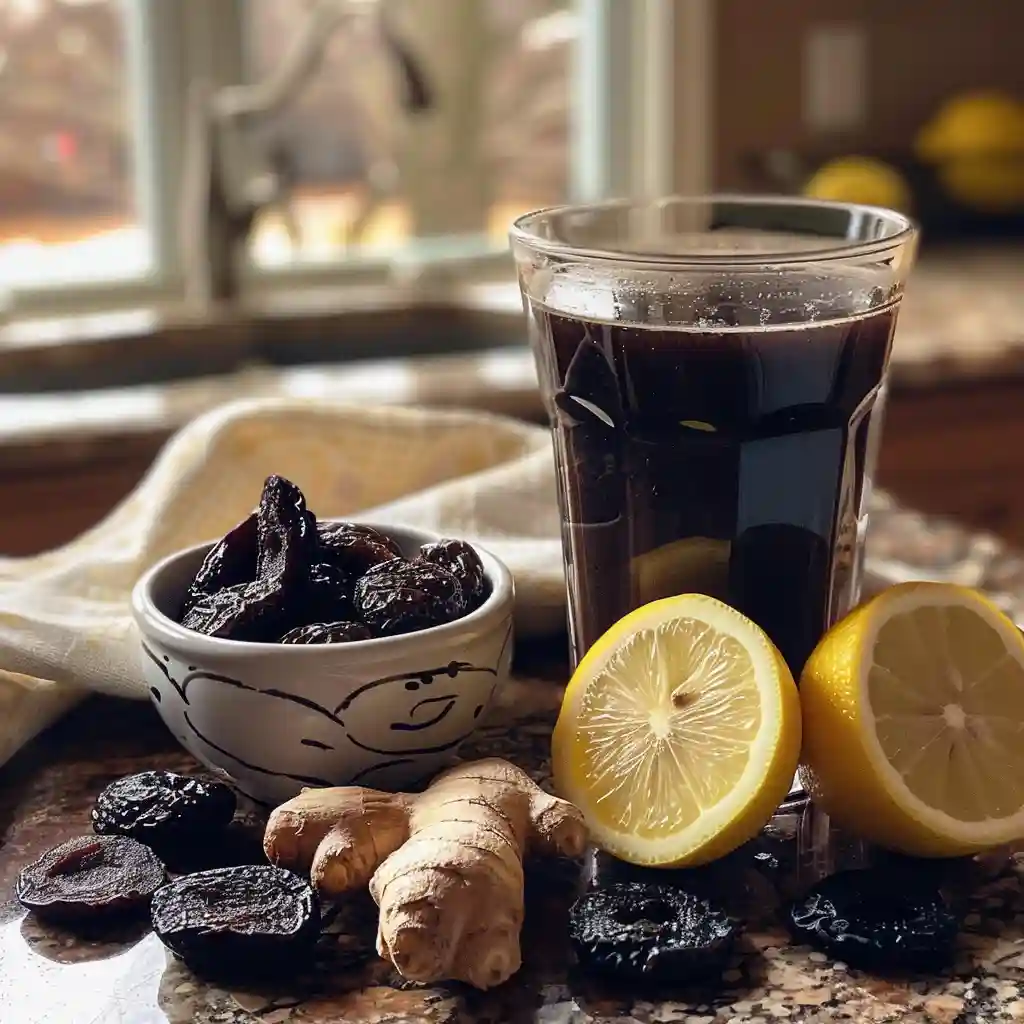In this article, I’ll guide you through creating a nourishing prune juice recipe right at home. We’ll explore ingredients, blending techniques, flavor upgrades, and natural digestive pairings. You’ll learn what to mix with it, how fast it may work for constipation, and other helpful tips from my personal journey.
This isn’t medical advice—just a home cook’s take on a traditional remedy that’s worked wonders for me and many others. Prune juice has been cherished in many cultures for generations, especially for supporting digestion gently and naturally.
Looking for inspiration? Try my personal favorite prune juice butter blend here
Table of Contents
PART 1: Why Make Your Own Prune Juice Recipe at Home
The Comfort of Homemade: Personal Experience with Store-Bought vs. DIY
From my early grocery runs, I remember grabbing bottled prune juice off the shelf thinking, “This’ll do the trick.” But it never quite hit the mark. Most store-bought versions tasted bland, overly sweet, or oddly metallic. That’s when I decided to try making my own prune juice recipe—and it changed everything.
Homemade prune juice is rich, smooth, and naturally sweet without the weird aftertaste. The freshness alone makes a difference, but more than that, there’s a simple joy in knowing what’s in your glass. No preservatives, no mystery ingredients—just real prunes and water.
I still remember the first time I blended soaked prunes with warm water—it was like making a warm tea-meets-smoothie experience. Since then, I’ve refined the prune juice recipe with a few gentle touches that make it part of my daily wellness routine.
Traditional Uses of Prune Juice for Digestive Health
This juice isn’t just an old wives’ tale. Prunes have been traditionally used across cultures to help support digestion, thanks to their natural fiber and sorbitol content. While I can’t promise instant relief, I can tell you that drinking a small glass made from my favorite prune juice recipe helps me feel more regular and lighter.
In Moroccan homes, prunes are often simmered into tagines—showing just how deeply rooted their digestive reputation is. And in my own kitchen, it’s become my go-to when I feel a little “off” or heavy.
Some people drink it cold; I prefer it warm, especially first thing in the morning. It gently signals my system to wake up, much like my favorite herbal teas do.
Print
Prune Juice Recipe: The Simple Secret to Texture and Taste That Feels Just Right
A soothing, naturally sweet prune juice recipe made from scratch with warming options like ginger and lemon, perfect for gentle digestion and daily wellness.

- Total Time: 10 minutes (plus soaking)
- Yield: 2–3 servings
Ingredients
- 1 cup organic pitted prunes
- 2.5 cups warm filtered water
- 1 slice fresh ginger (optional)
- 1 tsp lemon juice (optional)
- 1 tsp raw honey or maple syrup (optional)
- 1/4 tsp fennel seeds (optional)

Instructions
- Soak the prunes in warm water for 20–30 minutes, or overnight for tougher prunes.
- Add soaked prunes and water to a blender. Include ginger, lemon juice, or other add-ins if using.
- Blend on high for 60 seconds until thick and smooth.
- Strain using a fine mesh sieve or nut milk bag for a silky texture, or keep it rustic and hearty.
- Pour into a glass jar. Enjoy warm, or chill and sip as desired.

Notes
Start with 4–6 oz in the morning on an empty stomach. Add-ins like chia seeds, cinnamon, or ginger can enhance both taste and digestive benefits. Store-bought versions don’t compare—this one is fresh, rich, and fully customizable.
- Prep Time: 10 minutes
- Cook Time: 0 minutes
- Category: Drink
- Method: Blended
- Cuisine: Home Remedy
Nutrition
- Serving Size: 1 glass (6 oz)
- Calories: 150
- Sugar: 18g
- Sodium: 5mg
- Fat: 0g
- Saturated Fat: 0g
- Unsaturated Fat: 0g
- Trans Fat: 0g
- Carbohydrates: 38g
- Fiber: 3g
- Protein: 1g
- Cholesterol: 0mg
PART 2: Ingredients You’ll Need for a Fresh Prune Juice Recipe
Choosing the Right Prunes: Pitted, Organic, or Dried?
I’ve tested all kinds—California-grown, Turkish, pitted, sun-dried, and organic. My favorite for a reliable prune juice recipe? Organic pitted prunes. They soak faster, blend smoother, and carry that deep caramel note I’ve grown to love.
Make sure they’re soft and plump. If they feel too tough, you might need to soak them longer or even simmer them a bit. I keep a bag in my pantry at all times because once you get hooked on this prune juice recipe, you’ll want it weekly.
Here’s a quick tip I’ve learned: avoid prunes coated with preservatives like potassium sorbate. It’s better to go with the ones that just list “prunes” as the only ingredient—clean and simple for a cleaner-tasting prune juice.
Water Quality, Optional Sweeteners, and Flavor Boosters
The base of this prune juice recipe is just two simple things: prunes and water. But like any good blend, it’s the little touches that elevate it.

- Water: Use filtered or spring water if possible. I boil it slightly before soaking for extra warmth and better absorption.
- Optional Sweeteners: Personally, I skip sugar, but if you like a little more depth, a teaspoon of raw honey or maple syrup does the job—especially if you plan to chill the juice.
- Flavor Boosters: Here’s where I get creative. A slice of fresh ginger, a squeeze of lemon, or a sprinkle of cinnamon can add more than just flavor—they bring added digestive benefits and a personal touch. Sometimes I toss in a few fennel seeds while soaking. It adds a hint of anise and soothes my stomach after a heavy meal.
Let’s break it down in a simple table you can reference:
| Ingredient | Purpose |
|---|---|
| Pitted Prunes | Fiber and natural sweetness |
| Filtered Water | Hydration and blending base |
| Fresh Ginger (optional) | Adds heat and may soothe digestion |
| Lemon Juice (optional) | Brightens flavor and supports metabolism |
PART 3: Step-by-Step: How to Make Prune Juice at Home
Soaking the Prunes for Optimal Texture and Taste
This step right here? It makes or breaks the prune juice recipe. I usually start with 1 cup of pitted prunes and soak them in 2.5 cups of warm water. Not boiling—just hot enough that you’d sip it comfortably as tea. Let them sit for 20 to 30 minutes—longer if the prunes are a little leathery.
Sometimes I let them soak overnight if I know I’ll need the juice in the morning. You’ll notice they plump up beautifully and the water darkens. That’s flavor seeping out, and you’ll want to keep that liquid—it’s liquid gold.
I learned this trick after a failed batch that came out gritty. Ever since, I never rush the soak—it’s one of the simplest yet most important parts of a smooth prune juice recipe.
Blending and Straining: How I Learned to Get the Smoothest Result
Once your prunes are fully softened, toss everything—prunes and soaking water—into a high-speed blender. I use a NutriBullet, but any blender will do if you let it run long enough.
Blend on high for about 60 seconds until it turns into a rich, thick puree. Now, this next step depends on your texture preference:
- Rustic & hearty? Leave it as is.
- Silky-smooth? Strain it through a fine mesh sieve or cheesecloth. I use a nut milk bag for the smoothest results.
Pour it into a glass jar, chill if you like, or sip it warm. Either way, it’s got this cozy, earthy sweetness that makes the prune juice recipe feel like something truly special—way better than anything from a carton.
PART 4: Creative Ways to Mix Prune Juice for Better Flavor
What Can I Mix with Prune Juice for Constipation Relief?
Prune juice on its own is great—but over the years, I’ve found that pairing it with the right ingredients not only boosts the taste but may also give digestion an extra nudge. That’s the beauty of customizing a prune juice recipe to fit your needs and mood.
One of my go-to combos is warm prune juice with a teaspoon of grass-fed butter. Strange? Maybe. But it’s inspired by an old Southern remedy I picked up on a road trip in Georgia. The healthy fat helps coat the gut and get things moving. If butter isn’t your thing, a few drops of olive oil can work just as well.
Here are a few more gentle add-ins I rotate depending on what my body needs:
- Chia seeds: Add bulk and fiber; I let them soak in the juice overnight.
- Lemon juice: Brightens the flavor and has been used traditionally to aid detox.
- Fresh grated ginger: A warming, stimulating root that pairs beautifully with prunes.
- Psyllium husk: Just a pinch adds bulk and has a long history of digestive use.
I’ll often drink a small glass of this blend mid-morning after a fiber-rich breakfast. It’s one of my favorite gentle rituals, especially after travel or big meals. The right prune juice recipe can be more than functional—it can be enjoyable.
Add-ins Like Lemon, Ginger, Chia, or Mint That Complement Taste and Function
Flavor shouldn’t be sacrificed for function. That’s my motto in the kitchen, and it applies to any prune juice recipe I make.
Prune juice has a naturally earthy, sweet profile. When I want something more vibrant, I’ll blend it with:
- Lemon and honey: Tart and soothing—great when you want something refreshing.
- Ginger and mint: A cooling-warming duo that I drink chilled on hot days.
- Cinnamon or nutmeg: Cozy and spiced, especially when served warm in winter.
Here’s a quick table of combos I’ve tried that actually taste great and work well for the gut:
| Add-In | Why I Love It |
|---|---|
| Chia Seeds | Adds texture and natural fiber |
| Fresh Lemon Juice | Brightens taste, supports metabolism |
| Ginger | Adds warmth and aids digestion |
| Cinnamon | Comforting spice, great in warm blends |
PART 5: How Quickly Will Prune Juice Relieve Constipation?
From My Experience: What to Expect in Timing and Comfort
I’ve had a few moments—especially after long flights or restaurant binges—where I felt sluggish and backed up. When I turned to my homemade prune juice recipe, I noticed gentle results within 6 to 12 hours.
It wasn’t instant, but that’s a good thing. The relief came slowly and naturally, without sudden urgency or discomfort. And that’s what makes a good prune juice recipe so appealing—it works with your body, not against it.
Some mornings I wake up, drink a small warm glass, and feel lighter by the afternoon. Other times, especially if I’ve gone a few days without fiber, it may take until the next morning.
Consistency helps. Drinking it regularly—even just three times a week—has made a noticeable difference for me. The real magic comes not from a one-time glass but from building a routine around a nourishing prune juice recipe that works with your rhythm.
Suggested Time of Day and Hydration Tips for Better Results
I get the best results when I drink it first thing in the morning—before coffee, breakfast, or checking my phone. It acts almost like a gentle wake-up call to my digestive system.
Here’s what I do on days I need extra support:
- Drink 8 oz of warm prune juice on an empty stomach
- Follow it with a glass of warm lemon water
- Go for a short walk or light stretching to encourage movement
And let’s talk hydration—prune juice works better when you’re hydrated. Dehydration can actually slow digestion, so I always aim for 6–8 glasses of water throughout the day when I’m relying on a prune juice recipe to help.
Some of my friends asked, “Can I drink it at night?” You can—but be mindful. If your digestive system is more active overnight, you might end up waking early. I reserve it for morning use unless I’ve had a late, heavy dinner.
PART 6: Other Homemade Juices That May Support Digestion
A Few Other Juices I’ve Tried: Pear, Apple, and Beet Blends
I’ve had seasons where I wanted to change it up a bit—maybe I was out of prunes or just in the mood for something new. That’s when I began experimenting with other fruits known for their digestive support. Still, I always return to my go-to prune juice recipe when I need something reliable.
- Pear Juice: Sweet, subtle, and loaded with fiber. When I steam fresh pears and blend them with a splash of water and lemon, the result is comforting and light. It’s become my second favorite after anything based on a solid prune juice recipe.
- Apple Juice (from scratch): Fresh apples, especially green ones, make for a tart and refreshing morning blend. I core and simmer them with a cinnamon stick, then blend and strain. This one’s great after a heavy meal.
- Beetroot and Carrot Juice: More earthy than sweet, but when mixed with apple or orange, it balances out. I like this combo when I feel bloated—it feels grounding and energizing.
- Warm lemon water with flaxseed: Okay, not exactly a juice, but this blend has helped me when I needed something very gentle. Stir ground flaxseed into warm lemon water and let it sit—it thickens slightly and goes down easy.
Comparing Them to Prune Juice Based on Personal Results
Let’s be real—none of these juices work quite like a tried-and-true prune juice recipe. They’re all helpful in their own way, but prune juice consistently gives me the most reliable results.
Here’s a comparison I’ve created based on taste, ease, and impact:
| Juice | Flavor Profile | Digestive Impact (From My Experience) |
|---|---|---|
| Prune Juice | Rich, sweet, earthy | Most effective & consistent |
| Pear Juice | Light, smooth, mildly sweet | Gentle & soothing |
| Beet-Carrot Juice | Earthy, slightly sweet | Energizing, light detox feel |
| Apple-Cinnamon Juice | Tart, fresh, spiced | Mildly effective |
Discover great ideas like this prune juice butter blend I swear by.
PART 7: When and How Often to Drink Prune Juice
My Daily Routine with Prune Juice and How I Adjust It Seasonally
I’ve settled into a rhythm with my go-to prune juice recipe over the years. For me, a small glass (about 4 to 6 ounces) in the morning on an empty stomach feels best. It’s become a grounding start to my day—especially during colder months when I warm it slightly like tea.
In the summer, I shift things a bit. I’ll chill it in the fridge overnight, then stir in lemon juice and mint. It’s refreshing, still effective, and fits that lighter seasonal vibe. The beauty of a good prune juice recipe is that you can easily adjust it to suit your needs year-round.
Here’s what a typical week might look like in my kitchen:
- Monday–Wednesday: 6 oz of warm prune juice with ginger first thing in the morning
- Thursday: A break—maybe switch to pear or beet juice
- Friday–Saturday: Back to my homemade prune juice recipe, sometimes mixed with chia seeds
- Sunday: Rest day or try a different digestive tea
It’s not about being rigid. It’s about listening to my body and knowing what works.
Cautions and Moderation: Listening to Your Body
Like anything, too much of a good thing can backfire. I learned that lesson after chugging a tall glass on an empty stomach after a week of no fiber. Let’s just say—take it slow.
If you’re new to the prune juice recipe routine, start with 4 ounces and give your body time to respond. Drinking more won’t necessarily speed things up—it might just lead to cramping or discomfort.
Also, if you’re sensitive to sorbitol or have IBS, you may want to consult with a professional or try gentler blends like pear or apple first. From my own experience, sticking to 3–4 days a week works best. It helps support my digestion without making it overly dependent on one source.
PART 8: Best Times and Pairings for Prune Juice Consumption
Drinking It on an Empty Stomach vs. Post-Meal
I’ve tried my favorite prune juice recipe at all hours, and here’s what I’ve found: drinking it on an empty stomach first thing in the morning delivers the smoothest results. It’s almost like priming your digestive engine for the day.
That said, when I’ve had heavier meals—like big holiday dinners—I’ll drink a glass of prune juice about an hour after eating. This seems to help with that “too full” feeling and gently encourages things to move along.
I avoid drinking it right before bed, though. Once, after a late-night glass, I ended up wide awake at 3 a.m. with stomach noises louder than my snoring dog. Lesson learned.
Pairing Prune Juice with Fiber-Rich Foods
The magic really happens when a prune juice recipe meets fiber.
If I’m sipping prune juice in the morning, I’ll often follow it with a breakfast that includes:
- Oats with flaxseed
- Whole-grain toast and avocado
- Greek yogurt with berries and chia seeds
These combos not only taste great but also help the prune juice recipe do its job.
When I’m on the go, I keep it simple—a prune juice shot and a banana. It’s quick, effective, and surprisingly filling.
Check out another fiber-packed recipe I pair with prune juice often: this butter bomb blend.
PART 9: Storage Tips and Make-Ahead Ideas
How I Store Prune Juice to Keep It Fresh All Week
Once I’ve blended a batch of my go-to prune juice recipe, I store it in a glass mason jar with a tight lid. Glass is my go-to—it keeps the flavor pure and doesn’t react with the juice the way plastic sometimes can.
If I know I’ll be drinking it daily, I make about 3 to 4 servings at once. This prune juice recipe keeps in the fridge for up to 5 days, though I usually finish it sooner.
I give the jar a gentle shake before pouring because the juice naturally separates a bit. That’s a good sign—it means there are no preservatives holding it together artificially.
Sometimes I’ll portion it into 6-ounce jars so I can just grab and sip in the mornings without thinking. It’s like having a personal juice bar in the fridge with a fresh prune juice recipe always ready.
Tips for Freezing and Reheating Without Losing Benefits
If I’m heading out of town or want to prep for the week ahead, I freeze extra juice made from my favorite prune juice recipe. Here’s how I do it:
- Use silicone ice cube trays to freeze in 1-ounce portions
- Once frozen, pop the cubes into a freezer-safe bag
- Label with the date—I aim to use them within a month
To reheat, I just drop 2–3 cubes into a mug and add warm water. Stir, sip, and enjoy the same comfort as a freshly blended batch.
If you prefer chilled juice, just defrost it overnight in the fridge. The taste holds up surprisingly well, especially if you’ve added ginger or lemon before freezing.

FAQs About Prune Juice Recipe
How do you make prune juice?
I soak about 1 cup of pitted prunes in 2.5 cups of warm water for at least 30 minutes. Then I blend the whole mix until smooth and strain if I want a thinner texture. That’s it—just prunes and water, the way I first learned on a chilly morning in Oregon.
What can I mix with prune juice for constipation?
I often add ginger, lemon juice, or even a little chia for an extra fiber boost. But the best trick I’ve found is blending prune juice with warm butter or olive oil—it sounds odd, but it works wonders and tastes comforting.
How quickly will prune juice relieve constipation?
In my experience, it takes anywhere from 6 to 12 hours. Some days it’s faster, some days slower—but it’s always gentle. I make sure to hydrate well and eat fiber-rich meals throughout the day for best results.
What homemade juice is good for constipation?
Besides prune juice, I’ve had good results with fresh pear juice and beet-apple blends. They’re lighter but still help. Still, prune juice remains the most consistent and reliable remedy in my kitchen.
Don’t miss our prune juice butter bomb for a truly comforting twist
Conclusion: A Gentle Sip Toward Daily Wellness
Making my own prune juice recipe has become more than a wellness habit—it’s a ritual I truly enjoy. From selecting the softest prunes to blending in a pinch of ginger or lemon, it feels like self-care in a glass. And the best part? It works gently, naturally, and with consistency.
I’ve learned through trial, travel, and a few recipe flops that the best remedies are often the simplest. No additives, no fuss—just fruit, water, and a bit of attention.
Whether you’re looking to support digestion, ease occasional constipation, or just try something nourishing, this juice is a terrific place to start.
Looking for inspiration? Try our buttery prune blend here
And if you’re ready for more cozy kitchen stories, don’t miss our updates on:
- Natural Zepbound Drink Recipe
- Chia Seed Water Recipe
- Hot Buttered Prune Juice
- Internal Shower Chia Seed Water
For a daily dose of recipe joy, check out my journey and latest blends on Facebook and on Pinterest.
This recipe is shared for informational purposes and is not a substitute for medical advice. Always consult a healthcare professional for personalized guidance.
Thanks for sipping along with me,







1 thought on “Prune Juice Recipe: The Simple Secret to Texture and Taste That Feels Just Right”